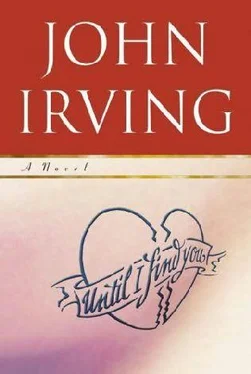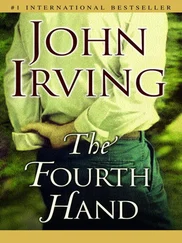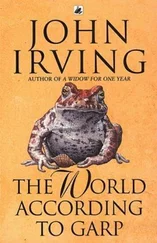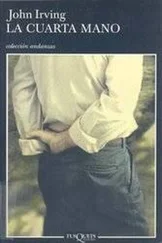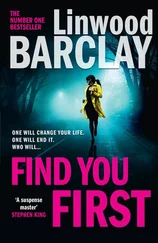At his mother’s insistence, Jack stopped crying so that they could go down to dinner.
“We’ll share the salmon,” Alice told the waiter.
“No reindeer tongue,” Jack said, “no cloudberries.”
Virtually no one else was eating in the restaurant. An elderly couple sat in silence; that they had nothing to say to each other did not necessarily predispose them to wanting a tattoo. A man was alone at a corner table. He looked depressed beyond desperation, a candidate for a fjord.
“A tattoo can’t save him,” Alice said.
Then a young couple came into the restaurant. It was the first time Jack saw how his mom was affected by a couple in love; she looked like a surefire fjord-jumper, one who wouldn’t even hesitate.
He was thin and athletic-looking, with long hair to his shoulders—like a rock star, only better dressed—and his wife or girlfriend couldn’t take her eyes or her hands off him. She was a tall, lanky young woman with a wide smile and beautiful breasts. (Even at four, Jack Burns had an eye for breasts.) Whether they were guests at the hotel or Oslo natives, they were as cool as any young couple who’d ever walked into Tattoo Ole’s. Probably they’d already been tattooed.
“ Ask them,” Jack said to his mom, but she couldn’t bear to look at them.
“No,” she whispered, “not them. I can’t.”
Jack didn’t understand what was the matter with her. They were a couple in love. Wasn’t being in love a pilgrim experience, like getting your first tattoo? Jack had heard his mom and Ole talk about those turning points in people’s lives that inspire a tattoo—almost any pilgrim experience will do. Obviously this young couple was having one. And if they were guests at the hotel, they’d probably already had sex that evening—not that Jack knew. (In all likelihood, they couldn’t wait to eat their dinner so they could have sex again !)
Not even the presence of the waiter, who stood ready to tell them the specials, could keep them from fondling each other. After the waiter had left with their order, Jack nudged his mom and said: “Do you want me to ask them? I know how to do it.”
“No, please—just eat your salmon,” she said, still whispering.
Even in that brutal weather, the young woman wore a skimpy dress and her legs were bare. Jack thought that they must have been staying in the hotel, because no one would have gone out in such a dress—not in that weather. He also thought that he spotted a tattoo—it might have been a birthmark—on the inside of one of her bare knees. It turned out to be a bruise, but that was what propelled the boy out of his chair and gave him the courage to approach the couple’s table. His mother didn’t come with him.
Jack walked right up to that beautiful girl and said the lines he still said in his bed to help him sleep.
“Do you have a tattoo?” (In English first. But if he’d spoken in Swedish, most Norwegians would have understood him.)
The girl seemed to think Jack was telling her a joke. The guy looked all around, as if he’d misunderstood what sort of place he was in. Was the boy what amounted to live entertainment? Jack couldn’t tell if he’d embarrassed the young man, or what else was the matter with him; it was almost as if it pained him to look at Jack.
“No,” the young woman answered, also in English. The guy shook his head; maybe he didn’t have a tattoo, either.
“Would you like one?” Jack asked the girl —just the girl.
The guy shook his head again. He regarded Jack strangely, as if he’d never seen a child before. But whenever Jack looked at him, he looked away.
“Maybe,” his beautiful wife or girlfriend said.
“I have the room and the equipment, if you have the time,” Jack told her, but something had distracted her. Neither she nor the man was looking at Jack; instead they were staring at his mom. She’d not left her table but she was crying. Jack didn’t know what to do.
The girl, seemingly more concerned for Jack than for his mother, leaned so far forward that the boy could smell her perfume. “How long does it take?” she asked him.
“That depends,” Jack managed to say, only because he knew the lines by heart. He was frightened that his mom was crying; in lieu of looking at his mother, Jack stared at the girl’s breasts. He became even more alarmed when he could no longer hear his mom crying.
“How much does it cost?” the guy asked, but not as if he were serious about getting a tattoo—more like he was trying not to hurt Jack’s feelings.
“That depends, too,” Alice said. She had not only stopped crying; she was standing right behind her son.
“Maybe some other time,” the guy said; a certain bitterness in his voice made Jack look at him again. His wife or girlfriend only nodded, as if something had frightened her.
“Come with me, my little actor,” Jack’s mom whispered in his ear. The guy, for some reason, had closed his eyes; it was as if he didn’t want to see Jack go.
Without turning around, the boy reached behind him. His hand, the one the clerk had hurt, instinctively found hers. When Jack Burns needed to hold his mother’s hand, his fingers could see in the dark.
Alice found few clients for tattoos in Oslo. Among the foreign guests and restaurant-goers at the Bristol, those intrepid souls who accepted her offer had been tattooed before.
Because their breakfasts at the Bristol were included in the price of their room, Jack and his mom continued their habit of overindulging in that meal. During one such exercise in overeating, they met a German businessman who was traveling with his wife. The German had a Sailor’s Grave on his chest (a sinking ship, still flying the German flag) and a St. Pauli lighthouse on his right forearm—the solid maritime tattooing of Herbert Hoffmann, whose shop in Hamburg was just off the Reeperbahn.
The German wanted Alice to tattoo his wife, who already had an eighteen-inch lizard tattooed on her back. After breakfast, the businessman’s wife selected an iridescent-green spider from Alice’s flash. Alice tattooed an all-black spiral on the German woman’s earlobe; the spider, suspended from a red thread, hung out in that hollow between her collarbone and her throat.
“Ambitious work, for Oslo,” Alice told the German couple.
Alice was looking forward to meeting Herbert Hoffmann; she’d always wanted to visit St. Pauli. Hoffmann, like Tattoo Ole and Tattoo Peter, represented those North Sea tattoos she’d first seen in her dad’s shop. She knew that Tattoo Ole had given Herbert Hoffmann his first tattoo machine, and that Hoffmann had been tattooed by Ole and Tattoo Peter.
Jack’s eagerness to get a look at Herbert Hoffmann was less professional. Ole had told the boy that Hoffmann had a big bird tattooed on his ass—the entire left cheek of his bum was a peacock with its fan in full-feather display! And Jack’s curiosity about Tattoo Peter had less to do with his reputation as a tattoo artist than the tantalizing fact that he had one leg.
But if seeing the German’s Herbert Hoffmanns made Alice wish she were in Hamburg, she was further disappointed that she was a whole week in Oslo before she got to tattoo a first-timer—“virgins,” Alice called them. Perhaps no one in Norway was seeking a pilgrim experience—at least not of that kind, or not at the Bristol.
In their continuing gluttony at breakfast, which stood in flagrant contrast to their near-starvation tactics at lunch and dinner, Jack learned to prefer gravlaks to smoked salmon. The cloudberries, which were offered with repeated zeal to children at every meal, turned out to be quite good; and while it was impossible to avoid the reindeer in one form or another, Jack managed to resist eating the poor creature’s tongue. But despite limiting their lunches and dinners to appetizers and desserts, the cost of their food was greater than the amount Alice was earning. And no one in Oslo wanted to talk to them about William. In Norway, the alleged object of William’s desire (and his subsequent ruin) was a girl too young to be comfortably discussed—even among adults.
Читать дальше
